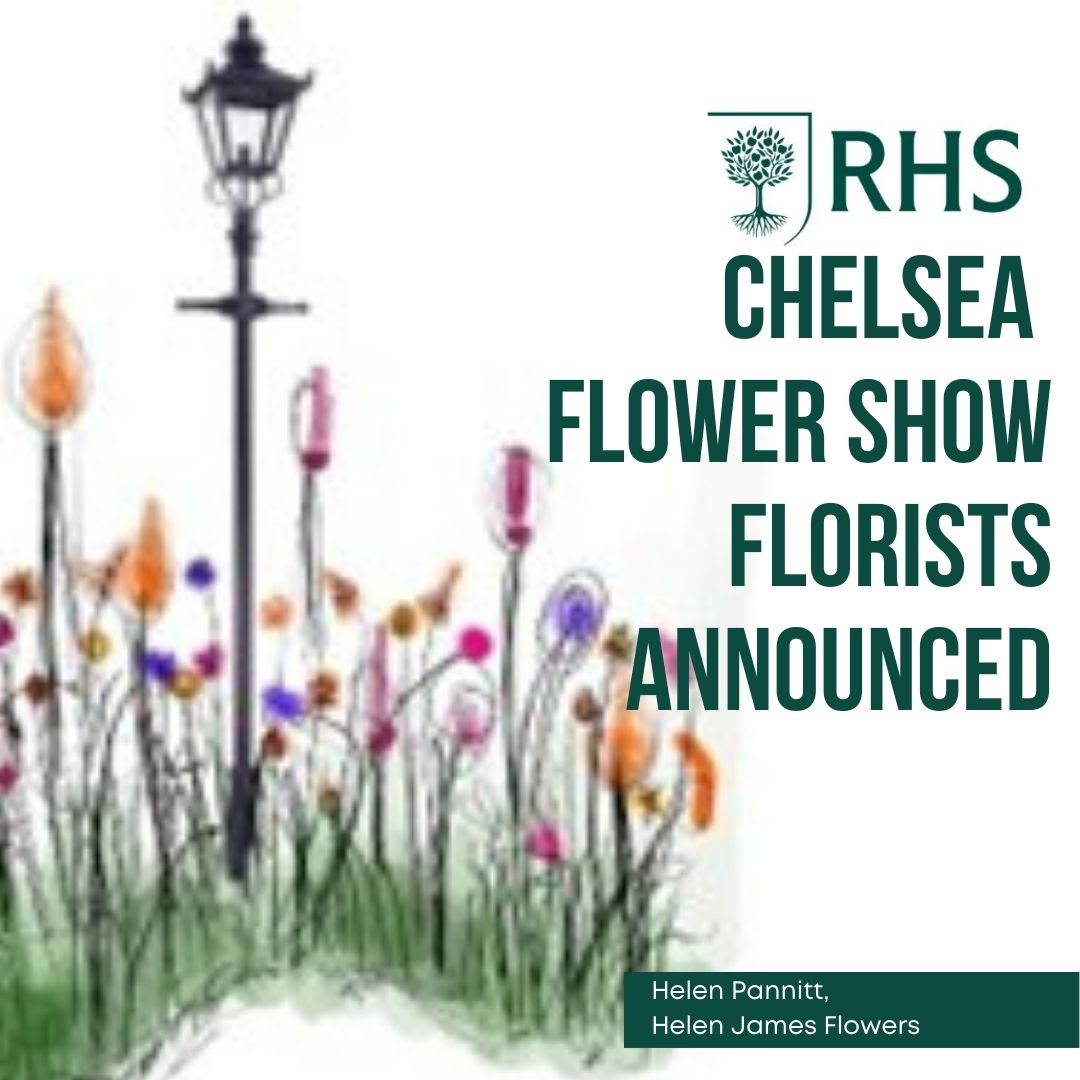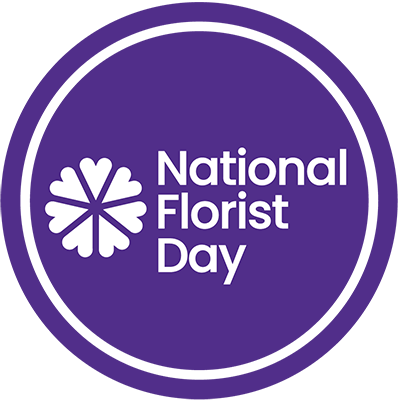
Who are the florists at Chelsea Flower Show '23
This year, floristry and floral design in the Great Pavilion has been revamped with florists competing across two categories: Floral Bins and Floral Lamp Posts. These structural starting points challenge artists to transform mundane items of street furniture into pieces imbued with a clear narrative.
The other categories are not eligible for Awards but do stretch the florists imagination and skill base to the full.
We bring you the full list of the 2023 participants and an insight to their designs and- as always - will be at the show to capture them all on camera!
Floral Bins
Wasting Time, Designed by Paula Routledge & Jade Loftus, Floral Media www.floralmedia.co.uk
Inspired by the message that the greatest threat to our planet is the belief that someone else will save it, this colourful, naturalistic waste bin design has sustainability at its heart. The flowers were grown at the designers’ flower farm with fresh ranunculus, peony, anemone, allium and apple blossom woven with dried flowers. Meanwhile, 24 natural clock faces highlight the urgent nature of the climate emergency: every hour counts. The flower bin is raised off the ground by a rebar frame made by a local farrier, illustrating the contrast between industry and nature.
Purple Passion Designed by Lara Thorpe, wild at Heart wildatheart.com
In this romantic, natural floral bin arrangement, foraged branches provide structure, along with other sustainably sourced and reusable materials. The designer has put together a therapeutic colour scheme encompassing shades of purple, from the palest lilac to deep wine, with carnation, delphinium, lilac and viburnum flowers taking centre stage. A supporting cast of greens and white flowers and foliage, including privet and spirea provide a calming foil.
Life’s Rich Tapestry Designed by Louise Hartley-English, Hartley English Flowers: hartleyenglishflowers.com
In this vibrant floral depiction of life’s ups and downs, the bin symbolises homelessness and addiction with moss, bottles and plants such as opium poppies, dried tobacco leaves and hemp. An ombré effect takes the scheme from an ‘oil slick’ of dark reds and black to brighter, more uplifting flowers symbolising healing and recovery. Supported by a twisted hazel frame, a kaleidoscope of colour, texture and scent explodes at the top – the light at the end of the tunnel.
Woven Tranquillity Sponsored by VD Export Designed by Acacia Creative Studio: acaciastudio.co.uk
This unappealing refuse bin has been transformed into a voluminous vase, overflowing with an abundance of pastel florals. Glimpses inside reveal the past life of this vessel, now the vital core of this design. Bringing a message of sustainability, a natural handcrafted willow vase envelopes the bin, showcasing a display of up to 500 florals in an understated colour and plant palette of peony, rose, delphinium, hydrangea and orchid.
My Floral Soul Designed by Nicola Hill, Gentle Blooms gentleblooms.co.uk
Inspired by the designer’s own flower farm, on which every stem on this exhibit was grown, and guided by sustainable mechanics, this floral bin design showcases delicate flowers on a framework of woven willow. The organic shape represents her environmentally friendly approach to flower farming; her growing journey as a florist and farmer; and the joyful impact this work has on her soul. Insects and birds made from natural materials are dotted around the display, while key seasonal blooms include aquilegia, delphinium, cornflower, persicaria, sweet rocket, geum, thalictrum and nigella.
A Botanical Spillage Designed by Julie Pearson juliepearsonfloraldesigner.co.uk
A cascade of bright botanicals trickling from an oil drum embody the dissonance between humankind’s actions and the natural world’s fragile beauty. The 2m-high waterfall of foliage, grasses, branches and seasonal British flowers includes clematis, lady’s mantle, allium, cardoon, dahlia and yarrow, tumbling from a tower of recycled aluminium containers lined with recycled wax. Handmade galvanised stub wire and reel wire pin holders complete the support system.
Tipping Point Designed by Anja Norris, Norris Floristry Norris.store
Inspired by the climate change crisis, the designer has tipped up the oil drum and out of it spills a cascade of blooms. The dark, pearlescent shades represent the damage being done to the planet, but as the floral ‘liquid’ hits the ground, it changes to brighter hues, highlighting the positive environmental changes that we can achieve. A woven-willow structure illustrates the strength of the environmental movement, while the punchy colours of roses, lady’s mantle, peonies, scabious and alliums bring hope that, despite reaching tipping point, humanity can repair the planet.
Eyes in the Line Designed by Elizabeth Askam and Kirsty Noble, Fresh Ideas Florists: freshideasfloristschesterfield.co.uk
Curated to challenge decorative norms and the hyper-nature of botanical industries, this design reflects a post-industrial landscape where nature has reclaimed its position of dominance. The designers have drawn inspiration from their own experiences around sustainability within the floral industry. Flamingo flower, lobster-claw, orchids, roses and seasonal flowers in a palette of hot, fiery colours convey the designer’s message of environmental urgency, while repurposed building supplies and recycled materials make up the structure.
The Beauty of Recycling Designed by Charlotte Baker, Hubbards Florist: hubbardsfloristcoventry.co.uk
A loose, flowing spiral of purples, green and lilac brings a decidedly romantic feel to this modern floral arrangement. Designed around a common metal rubbish bin and atop a bed of greenery and recycled glass bottles, it encourages an alternative view of the things we often simply throw away, highlighting the saying that one person’s rubbish is indeed another’s treasure. Key flowers include purple allium, scabious, amaranth and trailing amaranthus. Flat moss and the springy domes of bun moss provide a verdant anchor, while rose, wax flower, lisianthus, gerbera and gladiolus blooms add to the colourful display.
Floral Lamp Posts
Nature’s Resilience Designed by Grace Farrimond, Young Blooms Florist: youngblooms.co.uk
Collaborating with artisan carpenter Craig Cutlan-Wilson, the designer has created her interpretation of a strangler fig. This fascinating plant grows downwards from seed and serves as a powerful symbol of resilience and survival against the odds. Celebrating the circularity of nature and all its imperfections, the exhibit incorporates twisted willow and compost made from Wiltshire food waste with seasonal British flowers such as borage, scented stocks, alliums and verbascum.

Mͷp Designed by Jen & Lynn Jones, Jones & Jones Flowers jonesflowers.co.uk
Translating from the Ukrainian Mͷp as ‘Peace’, this predominantly yellow and blue floral lamp post celebrates the many Ukrainian refugees who have found host families in the UK. The lamp post represents the scaffolding that has been provided to help their movement from the darker planted base of the arrangement, rebuilding their lives stick by stick, up to the lighter top, where Ukrainian storks, made in collaboration with the designers’ refugee friends, fly free. Key yellow and blue flowers and foliage include agapanthus, yarrow, delphiniums, echinops, heleniums, iris, muscari and sweet peas.
My Bygone Street Designed by Jill Winton, Plantology Floral Creations plantologyflorist.co.uk
Inspired by an old-fashioned Sheffield streetlamp still lit by natural gas, this understated arrangement references the pathway where it’s found with an imagined sprinkling of flowers, which have naturalised to grow in the cobble crevices. Reclaimed Yorkstone recreates the street scene with birch and willow providing the structural elements. Dried and fresh seasonal British and European flowers include Queen Anne’s lace, feverfew, ferns and buttercup species, with cultivated mosses to bring a lived-in feel to the stones.
Floral Puddles Designed by Tina Aram
Under the warm glow of a streetlight lie ‘puddles’ of flowers in papier mâché bowls, each handmade by the florist from the paper used to transport flowers from Holland. Taking inspiration from the Japanese floral art of Hana-Kubari, flowers are supported by natural materials, including branches of pear wood and hazel. Linked together with clematis vines, the bowls hold floral materials from all stages of the lifecycle: seeds, flowers and seedheads. Ranunculus, hellebore, clematis, iris and anemones all feature, as well as beech leaves, bracken, grasses and moss gathered from the florist’s garden.

Light Dance Designed by Rose Cao rosecaofloraldesign.com
In this lamp post design, the light source comes from the energy of the colourful blooms, which dance and come together to illuminate the beauty of nature. The designer was born in Vietnam and her clean composition reflects an East-meets-West theme that’s neither as minimalist as Japanese ikebana nor as abundant as a typical European design, but rather a happy fusion of the two. A contrasting colour scheme of purple and yellow is vibrant and invigorating, harmonised with complementary colours. Two transparent structures of supporting orchids, spray roses and new cultivars of flamingo flower provide the main form for this asymmetrical design.
On the Verge Florist: Helen Pannitt, Helen James Flowers helenjamesflowers.co.uk
Taking inspiration from the rewilding of roadside verges and wastelands, the designer demonstrates how a simple space can be invigorated with plants while also creating habitats for birds, insects and other wildlife. It aims to show that by creating floral ‘hot spots’ in the suburbs, more people might enjoy these mini nature reserves on our verges, which too often are simply home to litter and fly tipping. Allium, campanula, ranunculus, tanacetum, scabious, sanguisorba and grasses combine for a rustic, naturalistic display of floral ingenuity and sustainability.
Floral Installations
Time to Change Designed by Kathryn Cronin, Fierceblooms fierceblooms.com
The wren is furious but also fearless. In a world that has forsaken its environmental roots he sings: “time to change”. Here, an enchanted wild garden-style floral compass points the way to a more sustainable floral future. Inspired by the flowers grown and dried in the designer’s canalside cutting garden, the installation uses British-grown seasonal purple, white and blue flowers – a nod to the coronation. Created using innovative, biodegradable mechanics, the wren, swan and their other wild garden friends invite you on your own sustainable floral journey.
Dreamscape Designed by Carly Rogers carlyrogersflowers.co.uk
Using dried flowers, grasses and moss, this design features an imagined landscape that exists between dreams and reality, life and death. This rugged still life of softly muted colours is a poem to nature in sculptural form. The design is structured around a large mound that slopes gently then meanders to ground level, allowing visitors to walk between and around the piece. A wild naturalistic mix of dried miscanthus, erba grass, hog weed, sea lavender and more seems to grow from a mossy earthy base.
 Infinite Meadows Designed by Emma McGeehan, Orchis Floral Design orchisfloraldesign.com
Infinite Meadows Designed by Emma McGeehan, Orchis Floral Design orchisfloraldesign.com
This walk-through mirrored tunnel, hung with lush greenery, was conceived in collaboration with the Project Seagrass charity and shines a spotlight on seagrass ecosystems. Forming dense meadows under the sea, seagrass plays a vital role in the health of our oceans. This playful exhibit uses sustainably grown bird’s nest fern, coral cactus, fishbone cactus and bear grass, with pieces ethically collected from seagrass meadows, to create a playful and immersive plantscape.
Flower Interpretations Designed by Harriet Parry harrietparryflowers.com
Central to this installation is an abstract artwork by Swedish painter Hilma af Klint. It includes dried British-grown and foraged flowers, such as hydrangeas, hop vines, delphiniums, moss and pampas grass, as well as plants, props and other materials. This thought-provoking standalone floral sculpture incorporates a specially commissioned contemporary soundscape and invites reflection on the wisdom of nature and how it must be protected.
Industrial Nature Designed by Mary Jane Vaughan maryjanevaughan.co.uk
Plants find a way to grow and thrive in the most inhospitable places. By fusing the durability and coldness of industrial design with the delicacy and ethereal quality of flowers, this installation imagines a world where humanity has realised the benefits of plants and flowers, and the most unlikely places are populated by nature. Here, waxy leaved string of pearls, trailing cacti and stephanotis lead the way, combined with delicate, papery butterfly ranunculus, roses, lisianthus and clematis. At ground level, water lilies and grasses rise from a metal structure, expressing hope and bounty.
Ikenobo Ikebana Rikka Shofutai Style Designed by Keiko Smith ikebanalondonclasses.com
The art of ikebana – specifically Rikka Shofutai – has 16th Century roots. Deep symbolism and Buddhist teaching combine to create harmonious works with exquisite balance and simple form. Here just nine stems, including pine, iris, English yew, hydrangea, aster and maple, are used in an installation reminiscent of Japan. Reusable pin holders and recyclable wire and paper tape provide support.
Annual Designed by Emma Thistlethwaite, thistlebynature.com
A celebration of ancient British landscapes, native flora and sacred sites, this botanical installation delivers a message of seasonality and respect for nature, while linking back to folklore and the lost stories of our past. It incorporates natural materials such as slate and stone, responsibly foraged foliage and branches, and British-grown native plants such as foxgloves, hawthorn blossom, wheat ears and poppy seedheads, both fresh and dried. The loosely circular piece can be admired from any point – an ode to the wheel of the year, as well as a nod to the circular sacred sites found up and down Britain.
The 5 Senses of Wellbeing Designed by Students from Capel Manor College
Bursting with vibrant and energising colours, this installation is a floral representation of how fresh flowers and foliage can stimulate all five senses to positively affect our wellness. Three moon gates depict quality of life, represented in bountiful floral form. Peonies, roses, grasses, eucalyptus and more combine in an energising palette of hot pink through to zingy lime green each of the senses.







